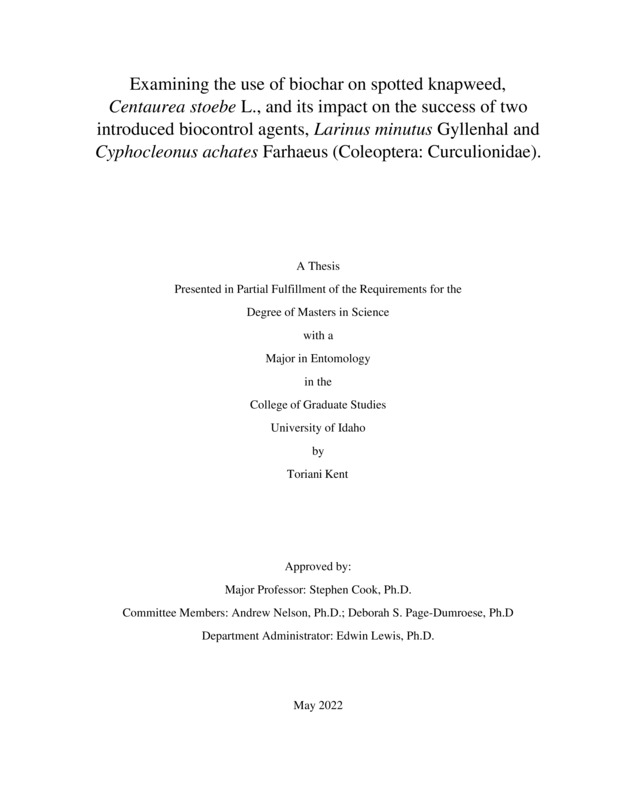Examining the use of biochar on spotted knapweed, Centaurea stoebe L., and its impact on the success of two introduced biocontrol agents, Larinus minutus Gyllenhal and Cyphocleonus achates Farhaeus (Coleoptera: Curculionidae).
Kent, Toriani Selene Anisa Maria Hope. (2022-05). Examining the use of biochar on spotted knapweed, Centaurea stoebe L., and its impact on the success of two introduced biocontrol agents, Larinus minutus Gyllenhal and Cyphocleonus achates Farhaeus (Coleoptera: Curculionidae).. Theses and Dissertations Collection, University of Idaho Library Digital Collections. https://www.lib.uidaho.edu/digital/etd/items/kent_idaho_0089n_12401.html
- Title:
- Examining the use of biochar on spotted knapweed, Centaurea stoebe L., and its impact on the success of two introduced biocontrol agents, Larinus minutus Gyllenhal and Cyphocleonus achates Farhaeus (Coleoptera: Curculionidae).
- Author:
- Kent, Toriani Selene Anisa Maria Hope
- ORCID:
- 0000-0002-6479-7149
- Date:
- 2022-05
- Embargo Remove Date:
- 2023-05-25
- Program:
- Entomology, Plant Path & Nematology
- Subject Category:
- Entomology
- Abstract:
-
Spotted knapweed (Centaurea stoebe L.) is potentially the most devastating invasive weeds in rangelands in the western United States, causing a reduction in rangeland productivity, foraging habitat for wildlife, and increasing erosion and stream sedimentation. Two of the most widely used biological control agents against spotted knapweed are Larinus minutus Gyllenhal (seed-head weevil) and Cyphocleonus achates Farhaeus (Knapweed root weevil) (Coleoptera: Curculionidae). However, their presence alone has not been enough to meet management needs. Biochar has been investigated as a potential control of invasive plants because it can be an alternative to removal or biological controls that have not been able to meet management's needs. This work examined the effects of biochar as a soil amendment on the susceptibility of spotted knapweed to L. minutus and C. achates, two biological control agents feeding on different parts of the plant. In a greenhouse, two biochar amendments (10% and 25% by volume) were used in standard greenhouse media. Biochar amendments increased the attack and presence of offspring in spotted knapweed attacked by C. achates . The attack by L. minutus was not as straightforward. Biochar appeared to make spotted knapweed seed heads less acceptable to attack while also decreasing the total number of seed heads produced by the plants. However, despite the success in the greenhouse, the field experiment did not provide supporting data. I used three biochar treatments (0, 10% and 25%) on field plots located near Bovill, ID and found no clear trend. Additional long-term monitoring of plants may be necessary as biochar can take time to move into the mineral soil profile after surface soil application. The majority of the results suggest that using biochar as a soil amendment in areas with spotted knapweed present would be most effective in conjunction with C. achates as the biological control agent, and the lower concentration is this study (10% by volume) of biochar added to the soil provided better results compared to the higher concentration tested.
- Description:
- masters, M.S., Entomology, Plant Path & Nematology -- University of Idaho - College of Graduate Studies, 2022-05
- Major Professor:
- Cook, Stephen
- Committee:
- Page-Dumroese, Deborah S; Nelson, Andrew; Lewis, Edwin
- Defense Date:
- 2022-05
- Identifier:
- Kent_idaho_0089N_12401
- Type:
- Text
- Format Original:
- Format:
- application/pdf
- Rights:
- In Copyright - Educational Use Permitted. For more information, please contact University of Idaho Library Special Collections and Archives Department at libspec@uidaho.edu.
- Standardized Rights:
- http://rightsstatements.org/vocab/InC-EDU/1.0/

